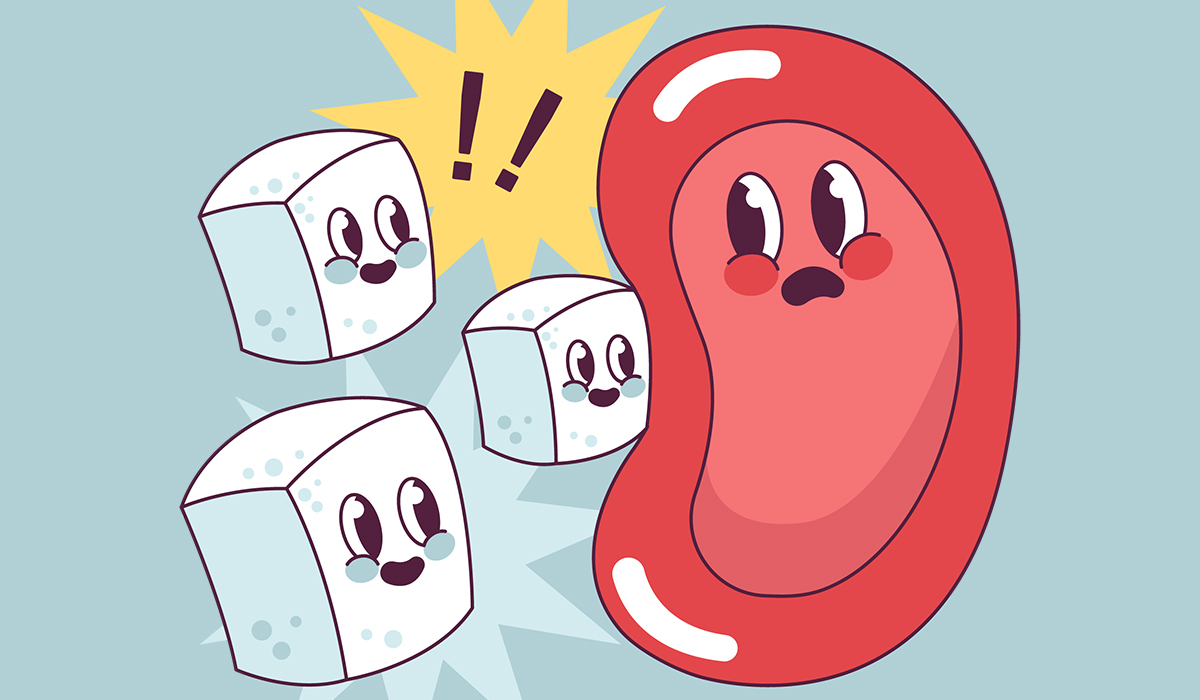Strep throat is the most often observed among children between 5 and 15 years old, but adults, especially parents and teachers, may also get infected. Because this bacterial disease is contagious, direct contact with infected children is the most common way for Streptococcus to spread, which occurs during talking, coughing, or sneezing – activities that release respiratory droplets containing the bacteria.
Sore throat and strep throat
The easiest way to differentiate between sore and strep throat is to remember that viral infections usually cause sore throat, while bacterial infections lead to strep throat. Some symptoms are the same for the two conditions, but several differences exist. For example, sore throat fever is usually milder than strep throat. In addition, nausea and vomiting are observed among people affected by strep throat and are rarely found in cases of sore throat, which causes nasal congestion instead.

Risk factors
Whether a person gets infected with Streptococcus bacteria depends on several factors. Children aged 5 to 15 are the most numerous group of people who get strep throat each year. The disease rarely occurs in people above 40 years old but is common among young parents and adults whose professions require close contact with children.
To sum up, factors that increase the risk of getting infected with Streptococcus bacteria are as follows:
- close contact with someone infected with Streptococcus bacteria
- working as a teacher, school nurse, or having another profession that requires close contact with children (child care worker, healthcare professional, etc.)
- working in crowded environments
- being a parent
- being between 5 and 15 years old
Symptoms
The most often observed symptoms of strep throat are throat pain and trouble swallowing, which results from inflammation of the throat and the surrounding areas. Another characteristic trait is high fever, which usually appears suddenly and worsens the following day.
All common symptoms linked to strep throat include the following:
- sudden, high fever 101˚F (38˚C) or higher
- loss of appetite
- chills
- abdominal pain
- red and sore throat and tonsils (tonsillitis)
- pain and trouble when swallowing
- throat with white patches
- swollen lymph nodes in the neck
- feeling exhausted
- muscle aches
- tiny red spots on the roof of the mouth or soft part of the palate
Cough, nausea, and vomiting that commonly occur in sore throat can sometimes happen in strep throat. However, it may indicate that you have a sore throat instead of strep throat or another viral infection.

Complications
Strep throat does not go away on its own. Without proper treatment that includes antibiotic regimen, and management at home, the infection may lead to additional, more severe health problems. The following health issues may occur due to untreated strep throat:
- spread of infection to tonsils, sin, blood, ear, or sinuses
- kidney inflammation (post-streptococcal glomerulonephritis)
- rheumatic fever (severe inflammation that targets joints, heart, skin, and nervous system)
- inflammation of the joints (post-streptococcal reactive arthritis)
- scarlet fever (a streptococcal infection that is characterized by a rash)
- inflammation of the membranes covering the spinal cord and brain called meningitis
- pockets of pus known as abscesses that can form around the tonsils
- guttate psoriasis (a condition that affects the skin, causing tiny, red spots on legs, arms, and torso)
- invasive streptococcal infection that occurs when bacteria enters tissue
To prevent the above complications from happening, make sure to contact your healthcare provider as soon as you notice that you or your child experience trouble when swallowing, high fever, and sudden fatigue.
Diagnosis and tests
The first step to properly diagnose strep throat is a physical exam performed by a healthcare professional and a visual examination to look out for visible symptoms caused by Streptococcus. Initially, it may cause a diagnostic challenge if some symptoms indicate a viral infection. Vomiting, nausea, coughing, cold, and runny nose, among others, can be caused by sore throat instead of strep throat, which is of bacterial origin. If that is the case, the doctor may order additional tests. The most popular ones include a strep throat test and a throat culture test.
A strep throat test is performed to determine if a group A Streptococcus bacteria exists in a person’s throat. The test involves using a long cotton swab to take a sample from a throat. To collect a sample, a healthcare professional must wipe the back of a throat with a swab so it may feel uncomfortable. The sample is then used to either perform a rapid strep throat test or a throat culture.
A rapid strep throat test takes only 20 minutes. If it is positive, it means a group A Streptococcus bacteria is present in a person’s throat, possibly causing strep throat. Although the negative result indicates no presence of the bacteria, a healthcare provider may decide to send the sample to a laboratory for further testing to perform a test known as a throat culture.
A throat culture test takes more time (1 – 2 days) but is more accurate. In this test, a lab technician smears a swab containing a patient’s sample on a dish. If Streptococcus bacteria grow from it, the test is considered positive.
Conventional treatment
Because strep throat is a bacterial infection, it can only be treated with antibiotic therapy. Streptococcus and many other bacteria can be killed and stopped from spreading thanks to appropriate antibiotics chosen by a doctor. In the case of strep throat, a doctor may prescribe one of eight antibiotics recommended by the Centers for Disease Control (CDC).
Strep throat patients commonly take antibiotics in the form of pills or liquids, but some healthcare professionals may prefer to give an antibiotic shot. The antibiotic regimen usually lasts about ten days.
It’s important to remember that strep throat does not go away on its own. Symptoms may improve after some time but are bound to return if antibiotic therapy is not followed. Some people stop taking antibiotics after a few days if they notice that their symptoms have vastly improved. Unfortunately, this only provides temporary relief, as the bacteria may attack again if it is not completely dealt with. Make sure to strictly follow the instructions of your healthcare provider, especially the time you need to take prescribed medications.
Management tips
In addition to treatment, there are several ways to help deal with strep throat at home. Here are some ideas you may try:
- Avoid hot food and drinks as they may irritate your throat.
- Drink cool beverages and consume cool meals to ease throat pain and reduce discomfort during swallowing.
- Avoid smoking and second-hand smoke, as these may also irritate the throat.
- Take over-the-counter medicines such as ibuprofen or acetaminophen to overcome swelling, severe pain, or high fever.
- Try sucking on ice cubes to ease throat pain and irritation.
- Consume a teaspoon of honey. You may eat it raw or add it to a beverage of your choice. Honey is also known to soothe the pain and swelling of an inflamed throat.
- Make sure to stay hydrated. Drinking plenty of water moisturizes and lubricates the throat, which makes swallowing easier.
- Rest a lot and avoid physical strain. During a bacterial infection, your body needs to preserve energy in order to combat the bacteria. Sleep whenever you need it, and don’t engage in activities that require a lot of energy.
- One of the best ways to ease pain also includes gargling with warm salt water. This method is recommended for adults and older children and involves gargling a mixture of salt and water a few times daily. All you need to do is add 1/4 of a teaspoon of salt (about 1.5 grams) to 8 ounces of warm water. Make sure not to swallow the mixture, but spit it out after gargling.
- Last but not least, if you have a humidifier, you may use it to add moisture to the air in your room.
Key facts
Strep throat is a contagious condition that spreads through respiratory droplets when infected individuals talk, cough, or sneeze. People at higher risk include those in close-contact professions, parents, and individuals aged 5 to 15.
Diagnosis involves physical exams, strep throat tests, and throat culture tests. Antibiotics are the primary treatment, and various options are prescribed based on the healthcare provider’s recommendation. Following the antibiotic regimen to the last day and listening to the doctor’s advice regarding management at home is vital to overcoming the disease and preventing it from returning.
Effective home management includes rest, staying hydrated, using pain relievers like ibuprofen or acetaminophen, avoiding irritants like smoke, and gargling warm salt water.
Sources
- MedlinePlus. (2021). Strep Throat.
https://medlineplus.gov/ency/article/000639.htm - NHS Inform. (2023). Streptococcus A (strep A).
https://www.nhsinform.scot/illnesses-and-conditions/infections-and-poisoning/streptococcus-a-strep-a - CDC. (2023). Strep Throat: All You Need to Know.
https://www.cdc.gov/groupastrep/diseases-public/strep-throat.html - Pennsylvania Department of Health. (2018). STREP THROAT FACT SHEET.
https://www.health.pa.gov/topics/Documents/Diseases%20and%20Conditions/Strep%20Throat.pdf - University of Utah Health. (2018). 4 TELL-TALE SIGNS YOU HAVE STREP THROAT.
https://healthcare.utah.edu/the-scope/health-library/all/2018/07/4-tell-tale-signs-you-have-strep-throat
